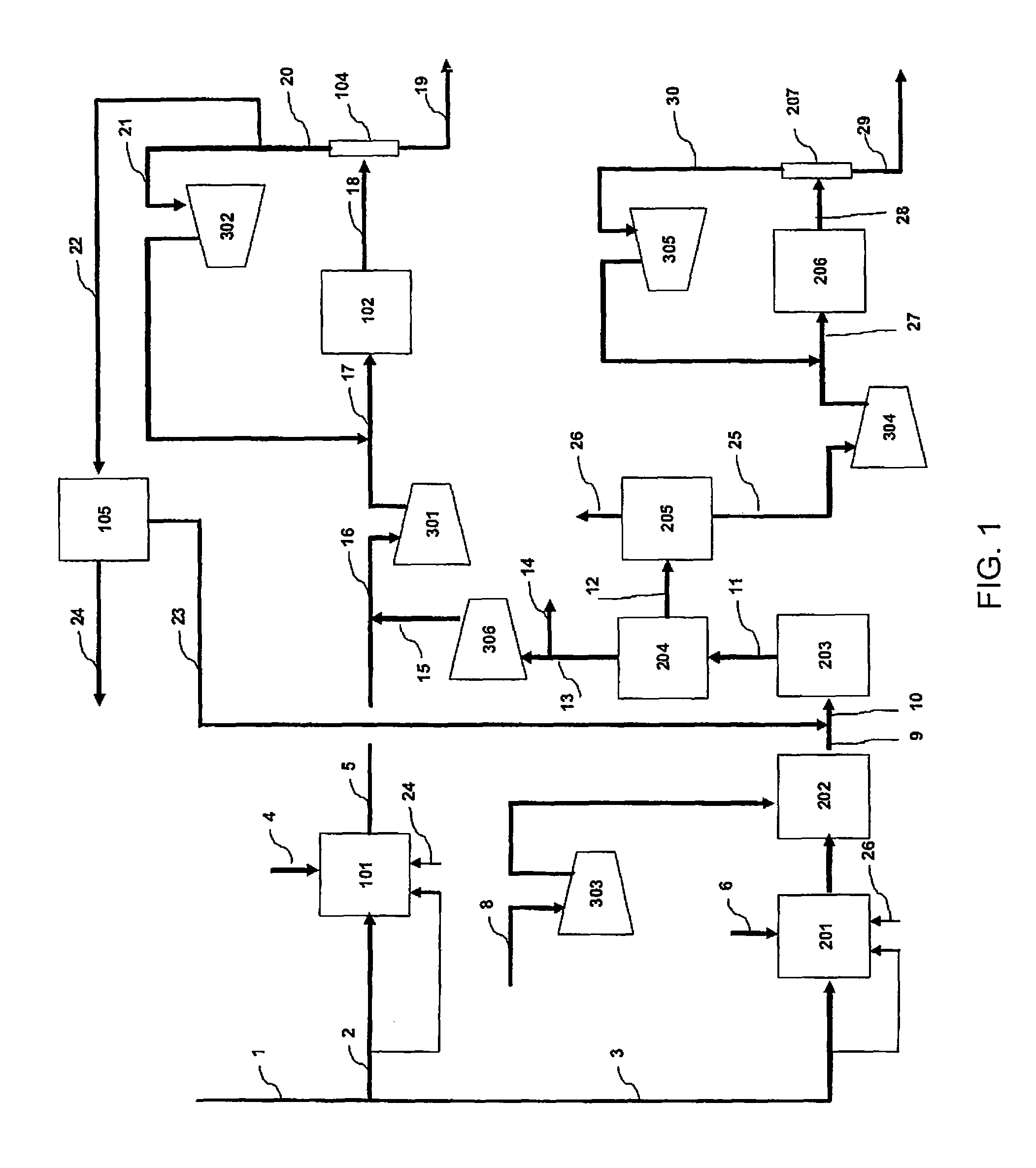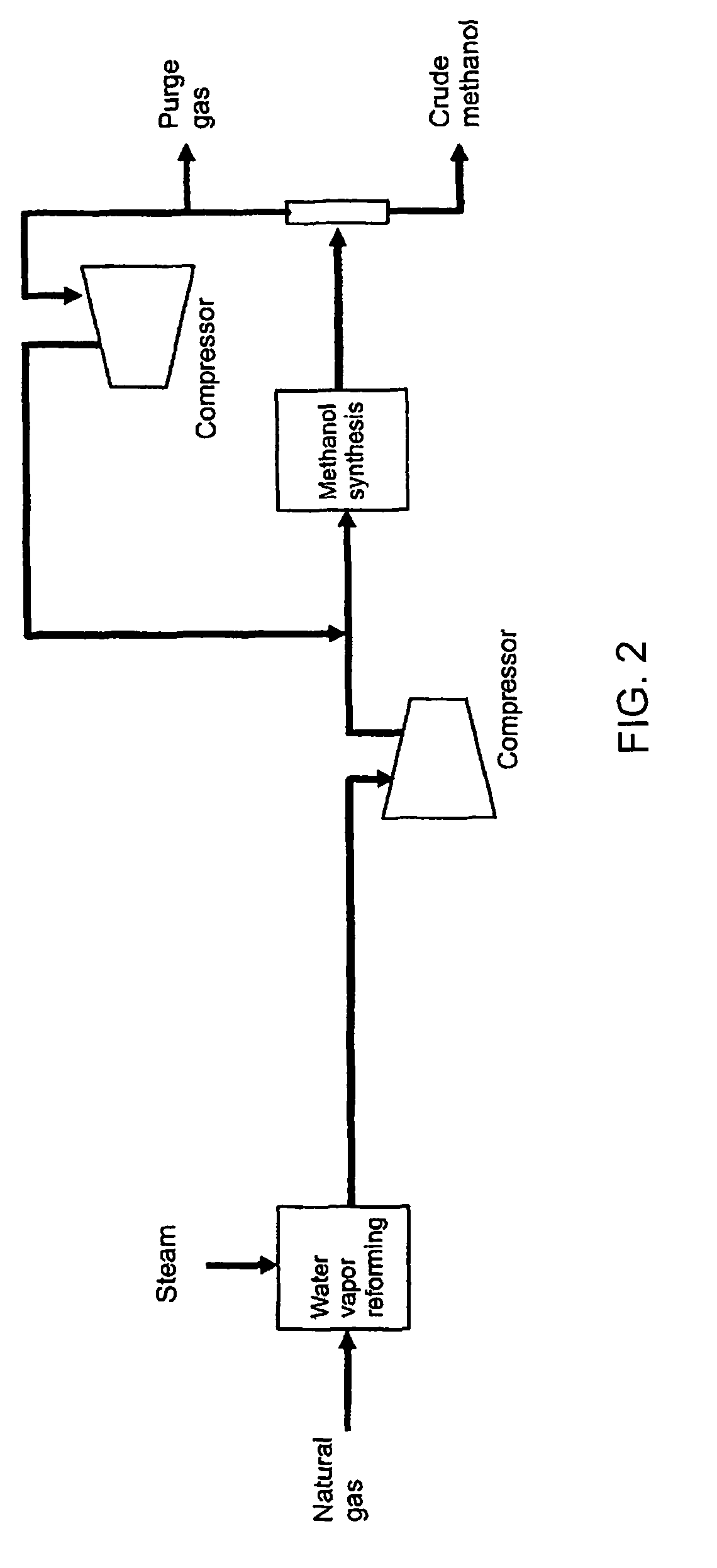Method of coproducing methanol and ammonia
a technology of methanol and ammonia, which is applied in the direction of chemical/physical processes, bulk chemical production, energy input, etc., can solve the problems of inability to carry out the production of only one of the two, the production amount of either one is remarkably small, so as to achieve the effect of efficient co-production of methanol and without increasing the specific raw material consumption
- Summary
- Abstract
- Description
- Claims
- Application Information
AI Technical Summary
Benefits of technology
Problems solved by technology
Method used
Image
Examples
example 1
[0056]In the flow scheme of FIG. 1, natural gas having the composition of Table 1 is supplied through the flow path 1 to a process for coproducing methanol and ammonia.
[0057]
TABLE 1Composition of Raw Material Natural Gas (Lower HeatingValue: 861.57 MJ / kmol)mol %Methane82.64Ethane7.56Propane2.12Isobutane0.59n-butane0.57n-pentane0.49Carbon Dioxide5.38Nitrogen0.65Total100.00
[0058]Table 2, Table 3 and Table 4 show the mass balance of the Example. The left column indicates the number of each line shown in FIG. 1, and the top rows indicate the pressure, the temperature, the flow rate, and / or the composition flowing in each line.
[0059]
TABLE 2PressureTemperatureFlow RateNumberMpa° C.kmol / hrNotes12.5825821922.58254050as raw material1453as fuel32.58252522as raw material194as fuel
[0060]
TABLE 3PressureTemperatureComposition (mol %)Flow RateNumberMPa° C.CH4COCO2H2O2N2 + ArCH3OHNH3H2OKmol / hr42.9527310012,99552.008752.110.75.749.00.132.425,74164.623551007,57274.0771315.22.56.726.30.30.049.112,0958...
example 2
[0066]In a methanol process shown by the flow scheme of FIG. 2 using 4050 kmol / hr of natural gas as raw material and an ammonia process shown by the flow scheme of FIG. 3 using 2522 kmol / hr of natural gas as a raw material, each natural gas being the amount equal to that of Example 1 described above, when the mass balance is calculated in the case of not using the carbon dioxide, which is removed in the ammonia process, for the methanol process, the amount of methanol production is naturally 3000 t / day, and as a conclusion of a standard balance calculation by those skilled in the art, it is determined that the amount of ammonia production is 2765 t / day, and the amounts of methanol and ammonia are the same as those of the Example 1 on a weight basis. In addition, it is also calculated that the specific consumptions of natural gas are also the same as that of the Example 1. Likewise, it becomes clear that the present invention provides a remarkable energy saving effect as compared wit...
reference example 1
[0069]In the methanol synthesis step 102 in FIG. 1 in Example 1 described above, given that methanol is produced in the same amount using a catalyst in the same amount as the amount of the catalyst required in the case of employing a reactor, as the reactor to which the mass balance shown in Table 3 is given, removing the heat of reaction in the form of steam generation by indirectly cooling a large number of reaction tubes that supply the boiler water to the shell side and are packed with the catalyst, when using a reactor having the characteristics of being capable of designing the temperature of operation at each point of the catalyst layers where the methanol synthesis reaction occurs so as to respectively have the maximum value of the reaction rate of methanol synthesis, at least the mass balance of the synthesis loops shown in Table 7 and Table 8 is obtained as easily estimated by those skilled in the art because of the structure provided with boiler tubes for generating steam...
PUM
| Property | Measurement | Unit |
|---|---|---|
| pressure | aaaaa | aaaaa |
| temperature | aaaaa | aaaaa |
| temperature | aaaaa | aaaaa |
Abstract
Description
Claims
Application Information
 Login to View More
Login to View More - R&D
- Intellectual Property
- Life Sciences
- Materials
- Tech Scout
- Unparalleled Data Quality
- Higher Quality Content
- 60% Fewer Hallucinations
Browse by: Latest US Patents, China's latest patents, Technical Efficacy Thesaurus, Application Domain, Technology Topic, Popular Technical Reports.
© 2025 PatSnap. All rights reserved.Legal|Privacy policy|Modern Slavery Act Transparency Statement|Sitemap|About US| Contact US: help@patsnap.com



